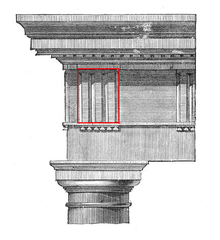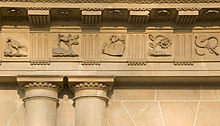299:
197:
252:
284:
268:
49:
236:
224:
212:
344:
409:
31:
161:, the earlier uses the first method, the later the second. There may be some variation in design within a single structure to allow for corner contraction, an adjustment of the column spacing and arrangement of the Doric frieze in a temple to make the design appear more harmonious. In the evolution of the Doric order, the placing of the triglyphs
140:) preserved this feature, as well as many other features common in original wooden buildings, as a tribute to the origins of architecture and its role in the history and development of man. The channels could also have a function in channeling rainwater.
298:
251:
148:
In terms of structure, a triglyph may be carved from a single block with a metope, or the triglyph block may have slots cut into it to allow a separately cut metope (in stone or wood) to be slid into place, as at the
173:
In post-Renaissance architecture the strict conventions are sometimes abandoned, and guttae and triglyphs, alone or together, may be used somewhat randomly as ornaments. For example, the
Baroque
196:
235:
267:
223:
283:
109:
of buildings using the Doric order. The absence of the pair effectively converts a building from being in the Doric order to being in the
364:
359:
158:
211:
105:, the six triangular "pegs" below, always go with a triglyph above (and vice versa), and the pair of features are only found in
132:
writers. The wooden beams were notched in three separate places in order to cast their rough-cut ends mostly in shadow.
429:
388:
434:
202:
413:
137:
133:
17:
85:, so called because of the angular channels in them. The rectangular recessed spaces between the tri
181:(1660s) has triglyphs and guttae as ornaments at the top of arches, in a facade using an eclectic
162:
82:
322:
90:
349:
One or more of the preceding sentences incorporates text from a publication now in the
258:
42:
8:
52:
304:
174:
384:
57:
48:
242:
150:
93:. The raised spaces between the channels themselves (within a triglyph) are called
229:
Triglyph blocks with slots for the insertion of metopes in the
Marmaria at Delphi.
61:
423:
355:
350:
290:
274:
154:
121:
241:
Triglyphs (slotted for the insertion of metopes) in the Doric frieze of the
110:
27:
Vertically channeled tablets of the Doric frieze in classical architecture
182:
129:
106:
75:
38:
368:. Vol. 27 (11th ed.). Cambridge University Press. p. 271.
117:
101:
in Greek. In the strict tradition of classical architecture, a set of
311:(1660s) has triglyphs and guttae as ornaments at the top of arches
125:
74:
is an architectural term for the vertically channeled tablets of the
261:
in Athens, showing Doric frieze with triglyphs and sculpted metopes.
30:
408:
308:
178:
120:
representation in stone of the wooden beam ends of the typical
78:
65:
217:
A metope (L) and triglyph (R) cut from one block from
Stratos.
102:
86:
116:
The triglyph is largely thought to be a tectonic and
421:
153:. Of the two groups of 6th-century metopes from
378:
381:The Dancing Column: On Order in Architecture
37:centered over the last column in the Roman
159:National Archaeological Museum of Paestum
354:
143:
47:
29:
14:
422:
277:with metope and triglyph in one piece
168:
24:
25:
446:
401:
289:Metopes from the second group at
407:
342:
297:
282:
266:
250:
234:
222:
210:
195:
64:(1754), triglyphs and decorated
372:
335:
203:Temple of Concordia, Agrigento
13:
1:
328:
205:, Sicily, with plain metopes
89:on a Doric frieze are called
7:
316:
10:
451:
383:. MIT Press. p. 187.
188:
165:, especially at corners.
430:Ornaments (architecture)
435:Columns and entablature
379:Joseph Rykwert (1998).
365:Encyclopædia Britannica
257:The entablature of the
83:classical architecture
68:
45:
323:Fascia (architecture)
144:Structure and placing
51:
33:
416:at Wikimedia Commons
43:Theater of Marcellus
138:Roman architecture
134:Greek architecture
124:, as described by
69:
46:
412:Media related to
169:Outside the Doric
16:(Redirected from
442:
411:
395:
394:
376:
370:
369:
348:
346:
345:
339:
301:
286:
270:
254:
243:Temple of Aphaia
238:
226:
214:
199:
163:evolved somewhat
151:Temple of Aphaea
21:
450:
449:
445:
444:
443:
441:
440:
439:
420:
419:
404:
399:
398:
391:
377:
373:
358:, ed. (1911). "
343:
341:
340:
336:
331:
319:
312:
302:
293:
287:
278:
271:
262:
255:
246:
239:
230:
227:
218:
215:
206:
200:
191:
171:
146:
28:
23:
22:
15:
12:
11:
5:
448:
438:
437:
432:
418:
417:
403:
402:External links
400:
397:
396:
389:
371:
356:Chisholm, Hugh
333:
332:
330:
327:
326:
325:
318:
315:
314:
313:
303:
296:
294:
288:
281:
279:
272:
265:
263:
256:
249:
247:
240:
233:
231:
228:
221:
219:
216:
209:
207:
201:
194:
190:
187:
170:
167:
157:, now in the
145:
142:
62:Bath, Somerset
26:
9:
6:
4:
3:
2:
447:
436:
433:
431:
428:
427:
425:
415:
410:
406:
405:
392:
390:0-262-68101-3
386:
382:
375:
367:
366:
361:
357:
352:
351:public domain
338:
334:
324:
321:
320:
310:
306:
305:Černín Palace
300:
295:
292:
291:Foce del Sele
285:
280:
276:
275:Foce del Sele
273:Section from
269:
264:
260:
253:
248:
244:
237:
232:
225:
220:
213:
208:
204:
198:
193:
192:
186:
184:
180:
176:
175:Černín Palace
166:
164:
160:
156:
155:Foce del Sele
152:
141:
139:
135:
131:
127:
123:
122:primitive hut
119:
114:
112:
108:
104:
100:
96:
92:
88:
84:
80:
77:
73:
67:
63:
60:
59:
54:
50:
44:
40:
36:
32:
19:
380:
374:
363:
337:
259:Hephaisteion
172:
147:
118:skeuomorphic
115:
111:Tuscan order
107:entablatures
98:
97:in Latin or
94:
71:
70:
56:
34:
183:Ionic order
136:(and later
130:Renaissance
39:Doric order
424:Categories
329:References
58:The Circus
414:Triglyphs
126:Vitruvius
53:John Wood
18:Triglyphs
360:Triglyph
317:See also
72:Triglyph
35:Triglyph
353::
189:Gallery
91:metopes
66:metopes
41:of the
387:
347:
309:Prague
179:Prague
103:guttae
87:glyphs
79:frieze
99:meros
95:femur
76:Doric
385:ISBN
128:and
362:".
307:in
177:in
81:in
55:'s
426::
185:.
113:.
393:.
245:.
20:)
Text is available under the Creative Commons Attribution-ShareAlike License. Additional terms may apply.

